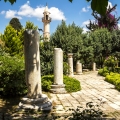The Primitive Way of Saint James is called primitive for a rather straightforward reason: it was the first road to Santiago that we know of. It covers the route taken by King Alfonso II “the Chaste” of Asturias to learn, first-hand, about the discovery of the Tomb of the Apostle St. James. The year was 834.
This route is about 320 kilometers long. It will take about fourteen days of walking, give or take. It is true that this route is more physically demanding than others, but it offers pilgrims a unique historical, contemplative, cultural, natural, and spiritual experience.
The route starts in Oviedo, Asturias, and then heads west through mountainous areas, green valleys, and quaint villages. From lush forests to high mountains, it is a great alternative to the better-known (and way more traveled) French Way. In comparison, this is the road less traveled.
Before starting the route, a visit to the Cathedral of the Savior and the Holy Chamber of Oviedo is mandatory. This is where the relic of the Holy Shroud, the famed Sudarium Domini, is kept. Tradition claims this is the cloth that wrapped Christ’s face in the tomb. After leaving the city, pilgrims will pass through rural landscapes dotted with small medieval chapels until they reach Grado.
The second stage covers the route from Grado to Salas. It goes through valleys and forests, and places of religious and cultural interest, such as the Sanctuary of El Fresno and the imposing Monastery of Cornellana. There, pilgrims can learn more about the local legend featuring a bear that saved a princess.
On the third day, pilgrims continue on to Tineo from Salas, enjoying the breathtaking views of this stage of the route. Here, they will also find the chapel of the Cristo de los Afligidos, the old carob tree of the Church of Saints Justo and Pastor, or the church of San Pedro de Tineo, which is believed to have been built by St. Francis of Assisi himself while on his pilgrimage to Santiago.
Between the fourth and fifth stages, up to Berducedo, the pilgrim can choose one of two routes. The first one is relatively easier, and goes through Pola de Allande, home to the sanctuary of the Virgen del Avellano. The second one is less traveled but certainly more appealing, as it goes through the ruins of the medieval pilgrims’ hospitals.
The sixth stage goes from Berducedo to Grandas de Salime, near the reservoir. It is a great spot for a visit, with its small chapels and the Collegiate Church of the Savior.
In the seventh stage, pilgrims cross the border between Asturias and Galicia through the Acebo pass until they reach A Fonsagrada. There, they can visit a sacred spring that, according to tradition, used to gush milk for a family that used to help pilgrims in need.
The eighth stage between A Fonsagrada and O Cadavo is full of rolling hills, beautiful rural landscapes, and ruins like those of the famous pilgrims’ hospital of Montouto, which was still up and running until the 20th century.
The ninth stage runs between O Cadavo and Lugo. You can still feel the echoes of St. Francis of Assisi’s famous pilgrimage to Santiago in this stretch of the road. He set up churches and convents all along the way, including that of Santa María de Vilabade. Another great spot to check out is the abandoned church of Soutomerille and the tower-fortresses around it.
Lugo is definitely worth a visit. Pilgrims are particularly drawn to its Roman wall and its cathedral. After leaving Lugo, the tenth stage crosses fields and forests until it arrives to San Román de la Retorta, where its beautiful church awaits.
The next stage is the last stretch of the Primitive Way, as it links up with Melide and the French Way. When in Melide, eating octopus is a must. Also, checking out Santa María and the Cruceiro de San Roque, the oldest in Galicia, is mandatory.
The twelfth stage runs between Melide and Arzúa –known for its soft and creamy tetilla cheeses. When going through it, you might want to stop by the church of Santiago de Boente.
As you get close to Santiago, you can’t miss out on a visit to Santa Irene: its waters are said to have healing properties. After O Pedrouzo, the last stage is the ascent to Monte do Gozo. From there, pilgrims finally enter Santiago and greet the Apostle –as King Alfonso did, 1200 years ago.




